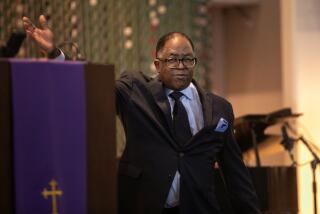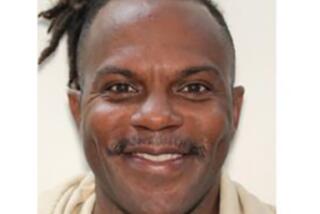Fullerton officers’ trial in death of homeless man begins Monday
Almost as soon as the baton blows began raining down on Kelly Thomas, the verdict from witnesses in a bustling Fullerton bus depot was clear.
“They’re freaking ruthless,” said one man in video captured by a bystander. “That’s enough,” a woman called out.
Now, two years later, an Orange County jury will be asked to render its own verdict on the incident that July night when a routine encounter between police and Thomas escalated into violence that left the mentally ill homeless man in a coma and dead five days later.
Former Fullerton officer Manuel Ramos, 39, is charged with second-degree murder and involuntary manslaughter. Former Cpl. Jay Cicinelli, 41, is charged with involuntary manslaughter and use of excessive force.
When the officers’ trial begins Monday, prosecutors will zoom in on their actions, such as a moment when Ramos pulled on a pair of white latex gloves and told 37-year-old Thomas, “Now you see my fists? ... They’re getting ready to f— you up.”
But the officers’ attorneys will challenge the notion that Thomas, who suffered from schizophrenia, was a passive, confused transient who helplessly weathered a beating from police until he crumpled to the ground, the blood running from his head.
“The evidence is going to show that Kelly Thomas has a violent history,” said John Barnett, Ramos’ attorney. “And that the police officers were going to let him go, wanted to let him go, that night. All he had to do is identify himself and he wouldn’t do that.... And he tried to escape, to get away, then he fought them when they were trying to restrain him.”
Barnett and Cicinelli’s attorney, Michael D. Schwartz, have indicated they will use Thomas’ criminal history and a 1995 report of chronic drug use to paint a more disturbing picture of Thomas than the one that emerged in the months after his death.
“For the past 2 1/2 years he’s been made out in the media as being a docile, gentle, passive homeless person and the reality is it’s almost the opposite,” Schwartz said.
In death, Thomas became an instrument of change in this college town. Images of his beaten and swollen face and a video of the confrontation caused many to question how police deal with the homeless and mentally ill.
In the aftermath, the city’s police chief left the department, three of five council members were recalled and city officials took the extraordinary step of clearing Thomas of any wrongdoing in the run-in with police.
The video, a 33-minute tape from the bus depot synced with audio from the officers’ recorders, will be a key piece of evidence in the trial. It shows brutal images of the encounter that night, including moments when Thomas screams out for his father — “Dad, they’re killing me” — and, repeatedly, “I can’t breathe.”
Without the tape, Dist. Atty. Tony Rackauckas, who is trying the case, has said it’s unlikely the same charges could have been filed.
When he announced the charges, Rackauckas said the video showed a confused Thomas doing his best to comply with the officers’ instructions.
Then, about 15 minutes in, Ramos pulled out the gloves and showed Thomas his fists. In that moment, Rackauckas said, the encounter escalated from a “fairly routine police detention to an impending beating by an angry police officer.”
A few minutes later, Cicinelli can be seen repeatedly using his Taser on Thomas and then using the butt of the Taser to hit Thomas in the head.
“I ran out … we ran out of options, so I got the end of my Taser and I probably … I just start smashing his face to hell. He’s on something, dude,” Cicinelli can be heard saying toward the end of the tape.
Defense attorneys will ask jurors to consider what goes unseen in the video. In addition to evidence of drug use, the defense is expected to introduce details of Thomas’ run-ins with the law to show that he had a propensity for violence.
Jurors will be allowed to hear about Thomas’ 1995 conviction for assaulting his grandfather with a fireplace poker, a 2004 arrest for slapping items out of a man’s hand and punching him in the cheek, a 2009 incident in which Thomas kicked a cardboard box and threw a watch toward a restaurant employee, and a 2010 conviction for trespassing at a fruit stand in Fullerton and throwing rocks in the direction of an employee.
The jury will also hear about a 2010 report that Thomas held his mother by the neck. Judge William Froeberg has not decided whether to admit another report that Thomas once threatened his mother with a butcher knife; Cathy Thomas has said she cannot recall telling an officer about the threat.
The defense is also expected to call Dr. Steven Karch to testify that Thomas’ cause of death was pre-existing, methamphetamine-induced heart disease. A coroner’s report found that Thomas’ death was caused by chest compression and blunt force trauma to the head suffered during the beating.
A doctor who wrote a report on Thomas following the assault on his grandfather, which concluded he likely sustained damage to his cognitive functions due to chronic drug use, is also expected to testify. Dr. Roberto Flores de Apodaca wrote that Thomas told him he used methamphetamines and did “a lot” of LSD up until 1994.
A toxicology report found that Thomas didn’t have any drugs or alcohol in his system the night of the beating.
Froeberg ruled, however, that if Dr. Flores de Apodaca could prove the damage was permanent and irreversible, “it might explain the demeanor of Mr. Thomas on the night of the incident.”
Ron Thomas, who since his son was beaten has led the charge to have the officers brought to justice, said he is angry about the defense’s portrayal of his son.
“They’re trying to say their client was justified in beating Kelly,” he said. “By beating him he died and that’s OK because Kelly was such a bad person. A mentally deranged drug user trained to kill.”
Susan Kang Schroeder, the D.A.’s chief of staff, said the efforts to paint Thomas in a negative light are par for the course.
“It’s normal defense 101 playbook to put the victim on trial instead, so they can divert the jury’s attention away from what their clients did,” she said.
And jurors — particularly in law-and-order Orange County — are likely to give the officers great leeway, experts said.
“What the prosecutors have to worry about is the juror who says, ‘I’d be scared. I’d want the police to do something. I don’t want them to go too far,’” said Laurie Levenson, professor of law at Loyola Law School and a former federal prosecutor. “But how do we know, on the spot, how far they should go?”
More to Read
Sign up for Essential California
The most important California stories and recommendations in your inbox every morning.
You may occasionally receive promotional content from the Los Angeles Times.











